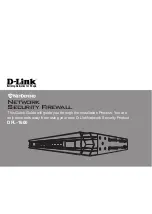SW6 - Port 2 “AN/Man”
This DIP-switch configures Port 2 for Auto Negotiation or Manual operation.
SW7 and SW8 - Port 2 Speed “100/10” and Duplex “FDX/HDX”
See Figure 4 for configuring duplex and speed when the port is configured for Manual operation.
DIP-SWITCH BANK 2
The functions of DIP-switch Bank 2 are outlined in Figure 4. DIP-switch Bank 2 controls the
operation of Port 3 and Port 4.
Switch
Legend
Function
DOWN
(Default)
UP
SW1
AN/Man
Port 3 Negotiation
AN
Man
SW2
100/10
Port 3 Speed
100
10
SW3
FDX/HDX
Port 3 Duplex
FDX
HDX
SW4
AN/Man
Port 4 Negotiation
AN
Man
SW5
100/10
Port 4 Speed
100
10
SW6
FDX/HDX
Port 4 Duplex
FDX
HDX
SW7
Off/On
Pause
Disabled
Enabled
SW8
On/Off
MAC Learning
Enabled
Disabled
Figure 3: DIP-switch Bank 2 Definitions
SW1 - Port 3 “AN/Man”
This DIP-switch configures Port 3 for Auto Negotiation or Manual operation.
SW2 and SW3 - Port 3 Speed “100/10” and Duplex “FDX/HDX”
See Figure 4 for configuring duplex and speed when the port is configured for Manual operation.
SW4 - Port 4 “AN/Man”
This DIP-switch configures Port 4 for Auto Negotiation or Manual operation.
SW5 and SW6 - Port 4 Speed “100/10” and Duplex “FDX/HDX”
See Figure 4 for configuring duplex and speed when the port is configured for Manual operation.
Port Operation
AN/Man
100/10
FDX/HDX
UTP Mode of Operation
AN
10 or 100 FDX or HDX When set to auto-negotiation the following modes are advertised:
1000FDX, 1000HDX, 100FDX, 100HDX, 10FDX, 10HDX
Man
100
FDX
The UTP port is set to manual and is forced to 100FDX
Man
100
HDX
The UTP port is set to manual and is forced to 100HDX
Man
10
FDX
The UTP port is set to manual and is forced to 10FDX
Man
10
HDX
The UTP port is set to manual and is forced to 10HDX
Figure 4: Speed and Duplex Selection
SW7 - Pause “Off/On”
The Pause DIP-switch sets the flow control functionality for all four ports on the module, including
pause mode advertisement, pause functionality, and half duplex back pressure. When the DIP-switch
is in the Pause Enable “On” position, flow control functionality is enabled. When this DIP-switch is
in the Pause Disable “Off” position (factory default), flow control functionality is disabled.
If Pause is Enabled on the module and the port is in half duplex, then half duplex flow control is
enabled. When a port is in half duplex flow control it generates a back pressure signal when internal
buffer resources are low.
If Pause is Enabled on the module and the port is in full duplex, then full duplex flow control is
enabled. When a port is in full duplex flow control and internal buffering resources are low, a pause
frame is generated to slow down the traffic flow to the port.
Page 2
Page 3
SW8 - MAC Learning
When this DIP-switch is in the Enable “On” position (factory default), all ports on the module will
learn the source MAC address of each received packet and store the address so packets destined
for the stored addresses can be forwarded to the appropriate interface on the module. When
the DIP-switch is in the Disable “Off” position, learning is turned off and all received packets are
forwarded to all ports.
2) INSTALL STANDALONE MODULE AND CONNECT CABLES
The 4GT is available in wall-mount models. For wall-mounting, attach the 4GT to a wall, backboard
or other flat surface.
For AC models:
To power the unit using the AC/DC adapter, connect the AC/DC adapter to an AC outlet. Then
connect the barrel plug at the end of the wire on the AC/DC adapter to the 2.5mm DC barrel
connector (center-positive) on the unit. Confirm that the unit has powered up properly by checking
the power status LED located on the front of the unit.
For DC Models:
To power the unit using a DC power source, prepare a power cable using a two conductor insulated
wire (not supplied) with a 14 AWG gauge minimum. Cut the power cable to the length required.
Strip approximately 3/8 of an inch of insulation from the power cable wires. Connect the power
cables to the unit by fastening the stripped ends to the DC power connector.
Connect the power wires to the DC power source. The Power LED should indicate the presence
of power.
WARNING: Note the wire colors used in making the positive and negative connections. Use the
same color assignment for the connection at the DC power source.
NOTE: If mounting with a safety ground attachment, use the safety ground screw at the rear of
the unit.
Connect the UTP ports via a Category 5 cable to a 10BASE-T, 100BASE-TX or 1000BASE-T
Ethernet device.


















